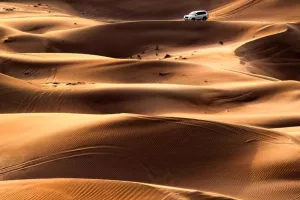A desert is a barren area with sparse vegetation, very little rainfall, dry air, and a surface completely covered by sand. One-third of the land area on the earth is desert. Most of the desert areas are sandy beaches or sand dunes, and rocks often appear. The desert soil is thin and there are few plants. Some deserts are salt flats or even completely devoid of vegetation.
Everyone will think that in such a barren area, no animals can survive, but in fact there are many animals living in the desert. Many oil reserves, valuable minerals and earlier fossils have also been discovered in the desert since modern times. Let's learn a little bit about the desert together!
When it comes to deserts, I believe that everyone’s first impression must be that it is open and boundless, and people are at a loss and can’t find the east, west, north and west, and it is difficult to find directional reference objects. It's dangerous to get lost in the desert, so how do people judge the right direction?
1. Everyone knows that the sun rises in the east and sets in the west, so we can judge a general orientation by the direction of the sun, which is also the easiest way.
2. The most common observation of celestial phenomena is to observe the North Star. In the night sky, there are seven stars arranged in a spoon-shaped Dipper constellation, with a bright star at the end of the spoon, the North Star. Directly below it is due north, and clockwise along it is east, south, and west.
3. The following judgment method is very popular and more convenient to use. We need to insert a one-meter long stick straight into the desert, and then make a mark with a stone on the top of the stick's shadow. The position of the sun has been changing, and the shadow of the stick will also change with the movement of the sun. After an hour, mark the shadow position at the top of the stick again. Finally draw a straight line between the two marks, and draw a vertical line in the middle of the straight line. This cross is a direction mark, the second mark is the east, and the clockwise order is south, west, and north.
Deserts appear as continuous sand dunes in natural landscapes, and endless sands form a vast desert. Why is there so much sand in the desert? In fact, it is mainly due to geographical reasons. Many deserts on Earth are behind tall mountains or in basins surrounded by mountains. The surrounding tall mountains are all above 3000 meters above sea level, and the temperature difference between day and night is large. Under the influence of "thermal expansion and cold contraction", the rocks on the mountains are easily broken, resulting in a huge amount of rock debris, which is under the action of long-term wind. Gradually converge into a desert.
Since the sand in the desert is inexhaustible, the question is, why can't we use them to build houses? Experiments have shown that desert sand is too fine, and its plasticity is poorer than that of river sand, making it difficult to form and not suitable for building materials. And although the sand in the desert is inexhaustible, the transportation cost is also a lot of money, and it is better to source materials on the spot in the river. So for anything, there is a reason why it is feasible or not.


